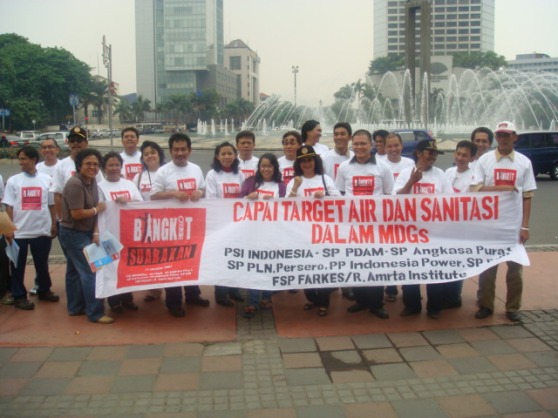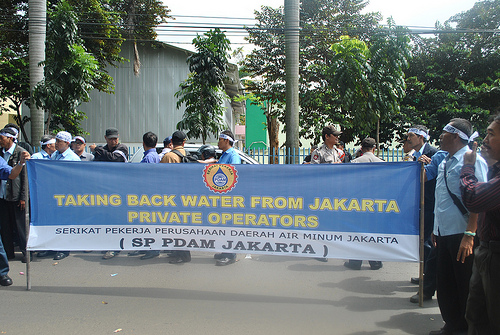Public sector workers have two options as their world and their workplaces are reorganised around them: they can either sit tight and try to defend the status quo or they can seize the initiative and try to influence the shape and direction of those changes (PSI, 1999.1)
In a capitalist economic system which by its nature divides society into two classes: those who own the workplaces and those who works for them. Therefore, those who work for them should stick together with their fellow workers. The understanding that workers, as individual, are powerless leads toward recognition that they share this powerlessness with others and they can change things through union. What a union does is give workers a voice in their workplaces, a way to put themselves on more equal footing with their employers (Yates, 2009). This statement is highlighted by Fieldes (2005) who states that in capitalist economic, union gives workers greater strength to resist their employers and more likely to be able to improve and protecting their rights in workplaces.
Tourine (1986) also states that union is also part of class conscious workers that accept the basic culture values of an industrial society but see themselves victims of the social control of economic activities. In addition, Hyman (1978) supports this statement by saying that unionism can be seen as embodying workers’ revolt against the deprivations inherent in their role: a revolt which can challenge the fundamental basis of capitalism on two fronts:
1) unionism represent a reaction against economic exploitation;
2) unionism is also raises issues of power and control
Whilst globalization has contested trade unions with the integration of global economy which challenges trade unions in declining membership. For unions, as national actors and as collective bargainers, this condition is better seen as a challenge for them to take more strategic actions and to impose their influence upon macro-economic and social policies of national governments. And, therefore, they are going to be able to minimize factors undermining the regulatory capacity of trade unions themselves to achieve the improvement in real wages and social benefits which had become part of workers’ normal expectation. Some unions that already relatively strong are able to limit the damaging effects of globalization. However, there are gap between strong and weak unions movements (Hyman, 2007)
Unions’ strength are based on number of memberships, thereof challenges of changing industrial and privatization of public services have been giving consequences for union to bear upon such as declining in membership (ibid. pp. 196). Meanwhile, trends of workplace flexibility, growth in part-time employment, feminization of workplace, increasing prevalent forms of atypical jobs, contracting out of services in which labour force has also increasing. These phenomenons are challenges trade union, and needs to deliberate carefully while referring to their identity and ideology under three-interrelated of market, class, and society in general circumstances. Those challenges should awake unions to be able to assess opportunities for intervention; to anticipate, rather than merely react to, changing circumstances; to frame coherent policies; and to implements and causal dynamics of organizational capacity (ibid. pp. 198).
Trade unions have always been a central focus for socialist directed toward working class mobilization and the transformation of capitalist society (Clarke and Clements, 1978), and in similar view, Yates (2009) states that trade unionism lead to workplace democracy, to change the relationship between employees and employers. Yates (ibid) adds that the more democratic the union movement, the more militant the working class is – the more the consciousness its leader has, the better of the workers and society end up being. Historically, unions have performed the role of converting their organizational space into a political space and contributing to the development of democratic institutions (Webster et al, 2008).
Friedrich Engel (1844) wrote that as schools of war, the unions are unexcelled. However, the major defeats for the working class and other popular movement were not generally being inflicted by direct political repression, but through economic reforms that were reconstituting the social relation of production inside national formations (Barrow,?). Therefore, unions should take the organizing initiative, if do not, employers and government certainly will and they will structure the workplace. Define the coverage, size and shape and nature of unions to suit their interests and not those of workers (PSI, 1999.1. pp 3). To do this, the unions would have to aware the solidarity and class consciousness that world hegemony is describable as a social structure, an economic structure, and a political structure; and it cannot be simply one of these things but must be all three (Cox, 1983).
However, in shaping the trade union power in face of global economic there is a need to build a virtuous circle of proactive capacity, active democracy and higher-level strategic support as the basis for an effective strategic for labour (Hyman, 2007 pp. 203). But Webster and Lambert (2001; Hyman, 2001) said building such a movement was challenging that labour movement are on defensive, having suffered a decline membership. Beside that the labour is facing ideological crisis (Webster and Lambert, 2001) which in came to control the agenda globalization and to define the issues and decide the battle was about. However, Clark and Clements (1978) believe in the ability of union as an agency of revolutionary change toward working class mobilization and the transformation of capitalist society. To do that, Clark and Clement (ibid) said that workers’ class-consciousness and solidarity is needed.

Indah Budiarti with affiliates of PSI in Indonesia campaign on Stand Up and Speak Up against poverty (2007)
Throughout the years the unions have developed into a number of forms influenced by different politic and economic as a result of the conflicts and struggle between capitalist class and working class: ‘the history of all hitherto existing society is the history of class struggle ‘, said Karl Marx and Friedrich Engels in the Manifesto of the Communist Party (1848). However Rob Lambert (2002) urges that union has source of powers in associated with their role workplace and society: associational power, structural power, symbolic power and political power. Therefore, definition provided by Webbs that union is “a continuous association of wage-earners for the purpose of maintaining or improving the conditions of employment”(1894) is too narrow because the union role goes beyond dealing with workplace issues and only representing wage earners.
However, it is undeniable that capital vicious attack on the working class and seemingly unending string of defeat. Therefore, Hyman (2001) firmly states that union must turn and shaping their identity as a sword of justice. However, that also depend on how the union able to use combination source of power in which led them to be strong and vibrant organization.
Although, there are no substantive different between public – private sector trade unions, however borne by the nature of work put the public sector unions at a significant challenges in political process of the governmental decision-making in which related to the public services. Public sector unions have to expand their scope of roles in response not only the desire of members for variety of benefits but beyond larger issues of current State affairs upon major changes concerning public services. Thus, for example, temptation of State to privatise essential services such as electricity, water, health system and education. However, public sector unions must be prepared to reorganize in face of such kind of public sector reform or privatization. Otherwise, if public sector unions failure to address these issues, the unions will disappear or irrelevant (PSI, 1999.1). Therefore, keeping the members loyal is a must that unions should be paying close attention to the continuous battle for the heart and minds of members (ibid).
In addition, attitude of workers towards unions and towards the concepts of public services should be a consideration in organizing public services workers. These points particularly affirm my assumption on Indonesia public service workers as they experience difficulties in organizing or attempt to attract members to actively participate in union. My another assumption regarding Indonesian public service workers is that they regard themselves as white-collar workers which makes them reluctant to lower their status to join with union. Or, according to Bent and Reeves (1978), the white-collar workers seem continues to identify him/herself with management, therefore does not evolve a working class consciousness.
Nevertheless, public services workers belief that unions giving them advantage in securing benefits, concern over working conditions and job-related matters. Therefore, growth and awareness is improving in spite of these difficulties. However, in successful organizing public sector unions should be seen as agent of change in the workplace and society to influence the shape and direction of those changes (PSI, 1999.1).
References:
Bent, Edward Alan and Reeves, Zane. T (1978). Collective Bargaining in the Public Sector. USA: The Benjamin/Cummings Publishing Company, Inc
Clarke, Tom and Clements, Laurie (1978). Trade Unions Under Capitalist. Glasgow: William Collins & Co Ltd
Fieldes, Diane (2005). From exploitation to resistance and revolt: the working class. Online, http://dspace.anu.edu.au/handle/1885/42632, last retrieved August 10, 2010
Hyman, Richard (2007): How Can Trade Unions Act Strategically? In: Transfer, Vol. 13, No. 2, 193-210
PSI (1999. 1). Organising Public Sector Workers. Ferney-Voltaire: PSI
Tourine, Alain (1986). Unionism as a social movement. In Unions in Transition: Entering the Second Century. Edited by Seymour Martin Lipset. San Fransisco: ICS, 1986. P. 151-173
Webster, Eddie et all (2008). Grounding Globalisation: Labour in the Age of Insecurity. Singapore: Utopia Press Pte Ltd
Webster, Eddie and Lambert, Rob (2001). “Southern Unionism and The New Labour Internationalism”, in Peter Waterman & Jane Wills (Eds), Place Space & the New Labour Internationalism. Oxford: Blackwell Publisher. Chapter: 3
Yates, Michael (2009). Why Union Matters? New York: Monthly Review Press (Second Edition)
NOTE: This article excerpted from my thesis and have been modified by 18 March 2011.


Pingback: Indonesia: when public services workers unionized « UNIONISM